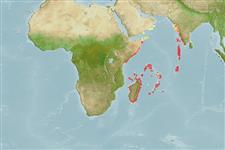Actinopterygii (ray-finned fishes) >
Clupeiformes (Herrings) >
Clupeidae (Herrings, shads, sardines, menhadens) > Dorosomatinae
Etymology: Sardinella: Latin and Greek, sarda = sardine; name related to the island of Sardinia; diminutive (Ref. 45335).
Environment / Climate / Range
Ecology
Marine; pelagic-neritic; depth range 0 - 50 m (Ref. 188). Tropical, preferred ?; 20°N - 27°S, 41°E - 83°E (Ref. 188)
Western Indian Ocean: western coasts of southern India, from Bombay south to Sri Lanka; also to Madagascar and Mauritius. Northwest Pacific: Taiwan (Ref. 12711), Hong Kong (Ref. 31075) and Viet Nam (Ref. 9706).
Size / Weight / Age
Maturity: Lm ? range ? - ? cm
Max length : 12.0 cm SL male/unsexed; (Ref. 188); common length : 10.0 cm SL male/unsexed; (Ref. 188)
Dorsal
spines
(total): 0;
Dorsal
soft rays
(total): 13-21;
Anal
spines: 0;
Anal
soft rays: 12 - 23. Total number of scutes 31 or 32. Lower gill rakers 88 to 126 (in fishes 9.5 to 11 cm standard length, strongly increasing with size of fish). Vertical striae on scales not meeting at center. The only other species of Sardinella with such a high gill raker count (more than 87) is S. fijiense (black caudal tips, western Pacific).
Forms schools in coastal waters.
Life cycle and mating behavior
Maturity | Reproduction | Spawning | Eggs | Fecundity | Larvae
Whitehead, P.J.P., 1985. FAO Species Catalogue. Vol. 7. Clupeoid fishes of the world (suborder Clupeioidei). An annotated and illustrated catalogue of the herrings, sardines, pilchards, sprats, shads, anchovies and wolf-herrings. FAO Fish. Synop. 125(7/1):1-303. Rome: FAO. (Ref. 188)
IUCN Red List Status (Ref. 115185)
CITES (Ref. 94142)
Not Evaluated
Threat to humans
Harmless
Human uses
Fisheries: minor commercial
More information
Common namesSynonymsMetabolismPredatorsEcotoxicologyReproductionMaturitySpawningFecundityEggsEgg development
ReferencesAquacultureAquaculture profileStrainsGeneticsAllele frequenciesHeritabilityDiseasesProcessingMass conversion
Tools
Special reports
Download XML
Internet sources
